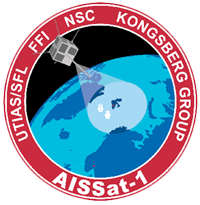The Global Maritime Distress and Safety System (GMDSS) is a worldwide system for automated emergency signal communication for ships at sea developed by the United Nations' International Maritime Organization (IMO) as part of the SOLAS Convention.
The International Convention for the Safety of Life at Sea (SOLAS) is an international maritime treaty that sets minimum safety standards in the construction, equipment and operation of merchant ships. The convention requires signatory flag states to ensure that ships flagged by them comply with at least these standards.

The automatic identification system (AIS) is an automatic tracking system that uses transceivers on ships and is used by vessel traffic services (VTS). When satellites are used to receive AIS signatures, the term Satellite-AIS (S-AIS) is used. AIS information supplements marine radar, which continues to be the primary method of collision avoidance for water transport. Although technically and operationally distinct, the ADS-B system is analogous to AIS and performs a similar function for aircraft.

A vessel traffic service is a marine traffic monitoring system established by harbour or port authorities, similar to air traffic control for aircraft. The International Maritime Organization defines vessel traffic service as "a service implemented by a competent authority designed to improve the safety and efficiency of vessel traffic and protect the environment. The service shall have the capability to interact with the traffic and respond to traffic situations developing in the vessel traffic service area". Typical vessel traffic service systems use radar, closed-circuit television, VHF radiotelephony and automatic identification system to keep track of vessel movements and provide navigational safety in a limited geographical area.
A sea lane, sea road or shipping lane is a regularly used navigable route for large water vessels (ships) on wide waterways such as oceans and large lakes, and is preferably safe, direct and economic. In the Age of Sail, they were not only determined by the distribution of land masses but also the prevailing winds, whose discovery was crucial for the success of long maritime voyages. Sea lanes are very important for seaborne trade.

The Maritime and Coastguard Agency (MCA) is an executive agency of the United Kingdom working to prevent the loss of lives at sea and is responsible, through the Secretary of State for Transport to Parliament, for implementing British and international maritime law and safety policy. It is also responsible for land based search and rescue helicopter operations from 2015.
The Maritime Transportation Security Act of 2002 (MTSA) is an Act of Congress enacted by the 107th United States Congress to address port and waterway security. It was signed into law by President George W. Bush on November 25, 2002.

A navigational aid (NAVAID), also known as aid to navigation (ATON), is any sort of signal, markers or guidance equipment which aids the traveler in navigation, usually nautical or aviation travel. Common types of such aids include lighthouses, buoys, fog signals, and day beacons.
The long-range identification and tracking (LRIT) of ships was established as an international system on 19 May 2006 by the International Maritime Organization (IMO) as resolution MSC.202 (81). This resolution amends Chapter V of the International Convention for the Safety of Life at Sea (SOLAS), regulation 19-1 and binds all governments which have contracted to the IMO.

Vessel Monitoring Systems (VMS) is a general term to describe systems that are used in commercial fishing to allow environmental and fisheries regulatory organizations to track and monitor the activities of fishing vessels. They are a key part of monitoring control and surveillance (MCS) programs at national and international levels. VMS may be used to monitor vessels in the territorial waters of a country or a subdivision of a country, or in the Exclusive Economic Zones (EEZ) that extend 200 nautical miles (370.4 km) from the coasts of many countries. VMS systems are used to improve the management and sustainability of the marine environment, through ensuring proper fishing practices and the prevention of illegal fishing, and thus protect and enhance the livelihoods of fishermen.

AISSat-1 is a satellite used to receive Automatic Identification System (AIS) signals. Launched on 12 June 2010 from Satish Dhawan Space Center as a secondary payload, AISSat-1 is in a sun-synchronous low Earth orbit. Initially a development project, the satellite has since passed into ordinary operations. Via downlinks at Svalbard Satellite Station and at Vardø Vessel Traffic Service Centre it tracks vessels in the Norwegian Sea and Barents Sea for the Norwegian Coastal Administration, the Norwegian Coast Guard, the Norwegian Directorate of Fisheries and other public agencies.
e-Navigation is a strategy developed by the International Maritime Organization (IMO), a UN specialized agency, to l shipping through better organization of data on ships and on shore, and better data exchange and communication between ships and the ship and shore. The concept was launched when maritime authorities from seven nations requested the IMO’s Maritime Safety Committee to add the development of an e-navigation strategy to the work programs of the IMO's NAV and COMSAR sub-committees. Working groups in three sub-committees and an intersessional correspondence group, led by Norway, has subsequently developed a Strategy Implementation Plan (SIP). Member states of IMO and a number of Intergovernmental and non-governmental organisations have contributed to the work, including the International Hydrographic Organization (IHO), Comité International Radio-Maritime (CIRM), the International Association of Lighthouse Authorities (IALA), the International Chamber of Shipping (ICS), the Baltic and International Maritime Council (BIMCO) and the International Electrotechnical Commission (IEC)
Maritime domain awareness (MDA) is defined by the International Maritime Organization as the effective understanding of anything associated with the maritime domain that could impact the security, safety, economy, or environment. MDA is said to work as a ‘key enabler’ for other maritime security issues, such as anti-piracy patrols, in the way that in order to do effective patrols you need to have the ability of conducting effective MDA. The maritime domain is defined as all areas and things of, on, under, relating to, adjacent to, or bordering on a sea, ocean, or other navigable waterway, including all maritime-related activities, infrastructure, people, cargo, and vessels and other conveyances.
The Marine Exchange of Alaska (MXAK) is a nonprofit maritime organization based in Juneau, Alaska. MXAK was founded in 2001 by retired United States Coast Guard Captain Edward Page, who along with Paul Fuhs and others in the maritime community established a Governing Board. The organization was established to broker information, that aids safe, secure, efficient, and environmentally sound maritime operations in Alaska. MXAK’s greatest advance in promoting maritime safety has been the establishment, operation and maintenance of an extensive vessel tracking network comprising over 140 Automatic Identification System (AIS) and Marine Safety stations in Alaska, complemented with satellite tracking systems. MXAK also serves the maritime community by assisting vessels, facilities and ports to comply with state and federal environmental, safety, and security regulations, and installing and maintaining weather stations at remote locations across Alaska. The Marine Exchange of Alaska is a presence in local, state, and federal meetings and workshops, advocating for cost effective measures that benefit Alaska and the maritime community.
The Maritime Monitoring and Messaging Microsatellite (M3MSat) is a tele-detection satellite developed by the Canadian Space Agency and launched in 2016. Its mission is to demonstrate and test the technology to assess the utility of having in space an Automatic Identification System (AIS) for reading signals from vessels to better manage marine transport in Canadian waters. The system will be supported by an instrument called a Low Data Rate Service (LDRS), which transmits AIS messages to ground sensors.

Navielektro /nɑvielektro/ is a privately owned Finnish company specialized in development and maintenance of situational awareness, surveillance and communication systems for both civilian and military purposes. Navielektro develops, manufactures and provides maintenance for a range of various radar and related sensors and communication equipment.
An emergency locator beacon is a radio beacon, a portable battery powered radio transmitter, used to locate airplanes, vessels, and persons in distress and in need of immediate rescue. Various types of emergency locator beacons are carried by aircraft, ships, vehicles, hikers and cross-country skiers. In case of an emergency, such as the aircraft crashing, the ship sinking, or a hiker becoming lost, the transmitter is deployed and begins to transmit a continuous radio signal, which is used by search and rescue teams to quickly find the emergency and render aid. The purpose of all emergency locator beacons is to help rescuers find survivors within the so-called "golden day", the first 24 hours following a traumatic event, during which the majority of survivors can usually be saved.
Bridge OperationsQuality Assurance is a methodology utilised in shipping and which originates from the similar FOQA/FDM concept in aviation. BOQA is a methodology with which ship owners/operators, ship Captains, and other associated shipping stakeholders can automatically and systematically monitor, track, trend and analyse operational quality of (seagoing) vessels. The main target with BOQA is to provide a non-punitive platform for proactive analysis of vessel data to enable the enhancement of maritime safety. The BOQA methodology can be used in both conventional manned ships and in autonomous or unmanned vessels providing that adequate data sources are available.

The Indian Navy's Information Management and Analysis Centre (IMAC) was approved in 2012 and operationalized in 2014. Located in Gurugram, it is the nodal agency for maritime data fusion that links information from the high seas and Indian's coastline and island territories.

The Integrated Coastal Surveillance System (ICSS) is a coastal surveillance system operated by India with the goal to protect its coastline, ensure regional security, and assist friendly navies by quickly detecting, locating and monitoring maritime activity in the Indian Ocean. The system was developed by the Defence Research and Development Organisation (DRDO) and Bharat Electronics, and forms part of the National Command Control Communication and Intelligence System (NC3I). Although the ICSS was built primarily for coastal and maritime security, the system can also be used for vessel traffic management, harbour surveillance and navigation. The core of the ICSS is a network of remote ground-based radar stations called the Coastal Surveillance Network (CSN). In addition to radars, stations are also fitted with optical sensors, electro-optical sensors, thermal imagers, cameras, meteorological systems, an Automatic Identification System (AIS), a distress alert transmission system (DATS), electronic warfare support measures, and very high frequency (VHF) radio communication systems.








